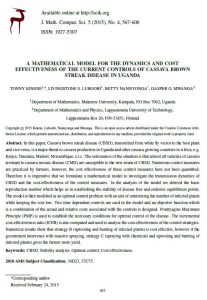In this paper, cassava brown streak disease (CBSD), transmitted from whitefly vector to the host plant and vice versa, is a major threat to cassava production in Uganda and other cassava-growing countries in Africa, e.g. Kenya, Tanzania, Malawi, Mozambique. The seriousness of the situation is that almost all varieties of cassava resistant to cassava mosaic disease are susceptible to the new strain of CBSD. Numerous control measures are practised by farmers; however, the cost-effectiveness of these control measures has not been quantified. Therefore, it is imperative that we formulate a mathematical model to investigate the transmission dynamics of CBSD and the cost-effectiveness of the control measures. In the analysis of the model, we derived the basic reproduction number which helps us in establishing the stability of disease-free and endemic equilibrium points. The model is then modified as an optimal control problem with an aim of minimising the number of infected plants while keeping the cost low. Two-time dependent controls are used in the model and an objective function, which is a combination of the actual and relative costs associated with the controls, is designed. Pontryagin’s maximum principle is used to establish the necessary conditions for optimal control of the disease. The incremental cost-effectiveness ratio is also computed and used to analyse the cost-effectiveness of the control strategies. Numerical results show that strategy B (uprooting and burning infected plants) is cost-effective; however, if the government intervenes with massive spraying, strategy C (spraying with chemicals and uprooting and burning infected plants) gives the farmer greater yields.
Region: Kenya, Malawi, Mozambique, Tanzania
Date published:
2015
Published by:
Plant Pathology
Type of resource:
Journal article
Resource topic:
Cassava
Project/Programme: Not specific
Pest/Disease: Cassava brown streak virus, Cassava mosaic virus
Pages:
34
File type:
External link (323 KB)




